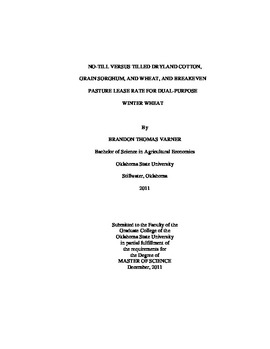| dc.contributor.author | Varner, Brandon | |
| dc.date.accessioned | 2014-04-15T18:35:42Z | |
| dc.date.available | 2014-04-15T18:35:42Z | |
| dc.date.issued | 2011-12-01 | |
| dc.identifier.uri | https://hdl.handle.net/11244/8359 | |
| dc.description.abstract | This study consisted of two papers. The research reported in the first paper was conducted to determine the optimal tillage and cropping system among three crops and two tillage systems. Yield data for cotton, grain sorghum, and wheat grown using no-till and tilled production practices were obtained from an experiment in southwest Oklahoma. Crop budgets were generated using the yield data and costs typical of the region for no-till and tilled systems. Net return distributions were subjected to risk analysis using stochastic efficiency with respect to a function. The research reported in the second paper was conducted to determine the wheat pasture rental rate at which dual-purpose wheat would breakeven with grain-only wheat. Wheat yields and beef gain were obtained from experiments conducted at the Wheat Pasture Research Unit near Marshall, Oklahoma. Yield and beef gain data were used to generate budgets and determine the breakeven wheat pasture rental rate for dual-purpose and grain-only wheat for three levels of wheat grain price: $3, $5, and $7 per bushel. Stochastic efficiency with respect to a function was used to compare net return distributions for dual-purpose wheat at varying levels of risk aversion. Findings and Conclusions: In comparison of crops and tillage systems no-till wheat generated the greatest net return; however, due to the variability in net returns for the no-till system, tilled wheat was determine to be the most risk efficient system for risk averse producers. No-till may be a viable option for producers who can put the time saved in the no-till system to productive use elsewhere or to use the time saved to farm more acres. The wheat pasture rental rate required for dual-purpose wheat to breakeven above cash costs (labor, machinery fixed costs, land, overhead, and management) with grain-only wheat is $0.30, $0.44, and $0.59 per pound of gain for wheat grain prices of $3, $5, and $7 per bushel. The breakeven pasture rental rate is sensitive to the price of wheat grain as well as to the price of nitrogen fertilizer. | |
| dc.format | application/pdf | |
| dc.language | en_US | |
| dc.publisher | Oklahoma State University | |
| dc.rights | Copyright is held by the author who has granted the Oklahoma State University Library the non-exclusive right to share this material in its institutional repository. Contact Digital Library Services at lib-dls@okstate.edu or 405-744-9161 for the permission policy on the use, reproduction or distribution of this material. | |
| dc.title | No-till Versus Tilled Dryland Cotton, Grain Sorghum, and Wheat, and Breakeven Pasture Lease Rate for Dual-purpose Winter Wheat | |
| dc.type | text | |
| osu.filename | Varner_okstate_0664M_11696.pdf | |
| osu.college | Agricultural Sciences and Natural Resources | |
| osu.accesstype | Open Access | |
| dc.description.department | Department of Agricultural Economics | |
| dc.type.genre | Thesis | |
| dc.subject.keywords | cotton | |
| dc.subject.keywords | dual-purpose wheat | |
| dc.subject.keywords | no-till | |
| dc.subject.keywords | risk analysis | |
| dc.subject.keywords | sorghum | |
| dc.subject.keywords | wheat | |
